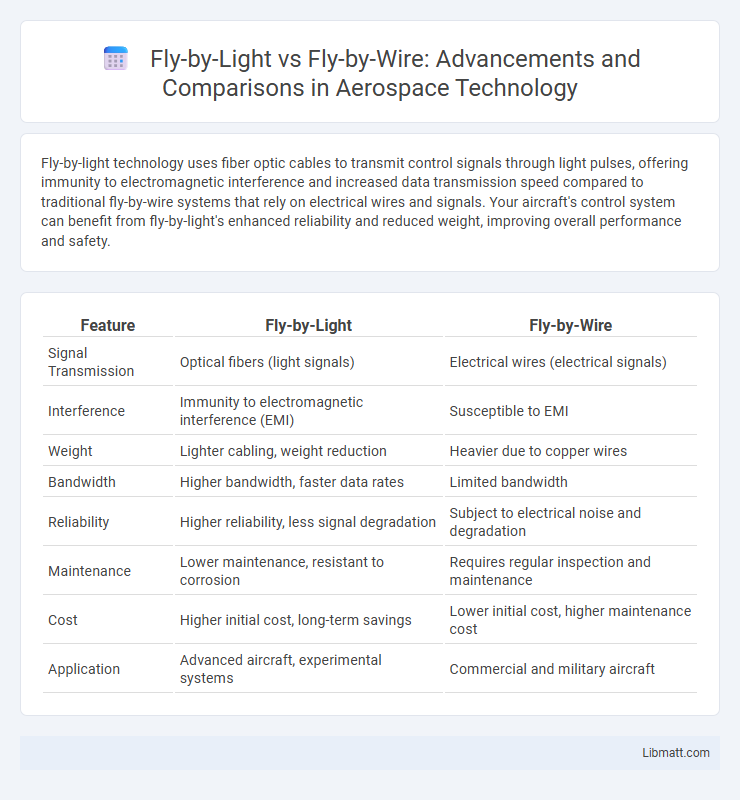Fly-by-light technology uses fiber optic cables to transmit control signals through light pulses, offering immunity to electromagnetic interference and increased data transmission speed compared to traditional fly-by-wire systems that rely on electrical wires and signals. Your aircraft's control system can benefit from fly-by-light's enhanced reliability and reduced weight, improving overall performance and safety.
Table of Comparison
| Feature | Fly-by-Light | Fly-by-Wire |
|---|---|---|
| Signal Transmission | Optical fibers (light signals) | Electrical wires (electrical signals) |
| Interference | Immunity to electromagnetic interference (EMI) | Susceptible to EMI |
| Weight | Lighter cabling, weight reduction | Heavier due to copper wires |
| Bandwidth | Higher bandwidth, faster data rates | Limited bandwidth |
| Reliability | Higher reliability, less signal degradation | Subject to electrical noise and degradation |
| Maintenance | Lower maintenance, resistant to corrosion | Requires regular inspection and maintenance |
| Cost | Higher initial cost, long-term savings | Lower initial cost, higher maintenance cost |
| Application | Advanced aircraft, experimental systems | Commercial and military aircraft |
Introduction to Fly-by-Wire and Fly-by-Light Technologies
Fly-by-wire technology replaces traditional mechanical flight controls with electronic systems using electrical signals to transmit pilot inputs to actuators. Fly-by-light systems use fiber optic cables to transmit data through light signals, enhancing immunity to electromagnetic interference and reducing weight. Both technologies aim to improve aircraft control precision and reliability, with fly-by-light emerging as a next-generation alternative to conventional fly-by-wire systems.
Historical Evolution of Aircraft Control Systems
Fly-by-wire technology marked a significant evolution from the earlier fly-by-light systems by replacing mechanical linkages with electronic signals, enhancing aircraft responsiveness and reducing weight. Early fly-by-light concepts, developed in the late 20th century, utilized fiber optics for control signal transmission to improve resistance to electromagnetic interference and improve data bandwidth. Your understanding of these advancements highlights how modern aircraft rely on fly-by-wire systems for precise, reliable control, while fly-by-light continues to influence future innovations in aviation technology.
Core Principles of Fly-by-Wire Systems
Fly-by-wire systems replace traditional mechanical flight controls with electronic interfaces that transmit pilot inputs through electrical signals to actuators, enhancing precision and reducing weight. These systems rely on flight control computers to interpret pilot commands and adjust control surfaces dynamically, enabling advanced stability and safety features such as automatic flight envelope protection. Redundant digital channels and sensors ensure system reliability and fault tolerance, making fly-by-wire a cornerstone in modern aircraft design.
Core Principles of Fly-by-Light Systems
Fly-by-light systems utilize optical fibers to transmit control signals as pulses of light, offering immunity to electromagnetic interference and enhanced data transmission speed compared to traditional electrical wiring. These systems rely on optoelectronic devices such as lasers, photodetectors, and modulators to convert electrical signals into optical signals and vice versa, ensuring precise and reliable communication. By minimizing weight and enhancing noise resistance, fly-by-light technology optimizes aircraft control performance and reliability, especially in high-speed and electrically noisy environments.
Key Differences Between Fly-by-Wire and Fly-by-Light
Fly-by-wire systems utilize electrical signals transmitted through wires to control aircraft flight surfaces, offering benefits like reduced weight and improved reliability compared to traditional mechanical controls. Fly-by-light technology replaces electrical signals with optical fibers, providing higher immunity to electromagnetic interference and greater bandwidth for data transmission, leading to faster and more accurate control responses. The key differences lie in signal transmission medium--copper wires versus optical fibers--and the resulting advantages in weight, electromagnetic compatibility, and data throughput.
Advantages and Disadvantages of Fly-by-Wire
Fly-by-wire systems replace traditional mechanical flight controls with electronic interfaces, offering advantages such as reduced weight, enhanced flight precision, and improved safety through automatic stability corrections. However, they depend heavily on software reliability and electrical power, which introduces risks of system failure or cyber vulnerability without robust redundancy. You benefit from increased maneuverability and reduced pilot workload but must consider the critical need for fail-safe backups and rigorous maintenance protocols.
Advantages and Disadvantages of Fly-by-Light
Fly-by-light systems offer significant advantages over traditional fly-by-wire technology, including immunity to electromagnetic interference and reduced weight due to fiber optic cables. This results in increased system reliability and enhanced performance in harsh environments. However, the disadvantages include higher costs, complexity in installation and maintenance, and potential challenges in signal conversion, which may impact Your decision depending on the application requirements.
Applications in Civil and Military Aviation
Fly-by-light systems use fiber optic cables to transmit control signals, offering immunity to electromagnetic interference and reduced weight compared to traditional fly-by-wire systems that rely on electrical wiring. In civil aviation, fly-by-light technology is increasingly explored for next-generation aircraft to enhance safety and performance, particularly in electrically noisy environments like commercial airliners. Military aviation benefits from fly-by-light by achieving faster signal transmission and enhanced survivability against electronic warfare, making it ideal for advanced fighter jets and unmanned aerial vehicles.
Future Trends in Aircraft Control Systems
Fly-by-light technology offers significant advantages over traditional fly-by-wire systems by using fiber-optic cables for signal transmission, resulting in faster response times, reduced electromagnetic interference, and lighter weight. Future trends indicate a growing integration of photonic components in aircraft control systems to enhance reliability and bandwidth, crucial for next-generation autonomous and highly interconnected aircraft. As your aircraft demands evolve, adopting fly-by-light systems promises improved performance, safety, and data handling capabilities essential for advanced avionics.
Conclusion: Which Technology Leads the Future of Aviation?
Fly-by-light technology offers significant advantages over traditional fly-by-wire systems by utilizing fiber-optic cables, which reduce electromagnetic interference and weight, enhancing aircraft performance and reliability. Your aviation investments in fly-by-light promise greater data transmission speed and immunity to signal degradation, critical for next-generation autonomous and high-speed aircraft. As the industry advances, fly-by-light emerges as the leading technology shaping the future of aviation control systems.
Fly-by-light vs Fly-by-wire Infographic

 libmatt.com
libmatt.com